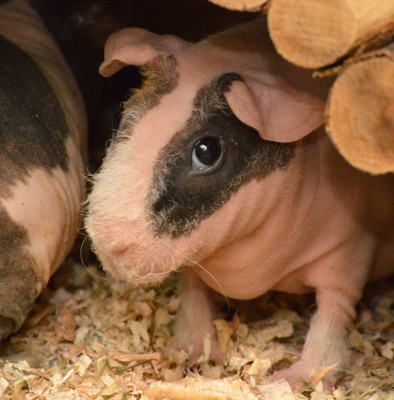
We gave you the skinny on the skinny pigs throughout the month, but now it’s time to say good-bye to our Animal of the Month for September. We hope you enjoyed our tweets about skinny pigs, perhaps with a little patriotic pride knowing that they were created right here in Canada! If you missed that tweet or any others, here is a summary of the fascinating facts about skinny pigs. Did you know?:
- The skinny pig is a hairless guinea pig and has the same scientific name as the guinea pig (Cavia porcellus).
- Skinny pigs are guinea pigs that have a genetic mutation which makes them mostly hairless.
- Did you know that skinny pigs have a unique Canadian connection? They were created in Canada!
- In 1978, Montreal scientists first identified the genetic mutation that created hairlessness among lab guinea pigs.
- Researchers later bred the guinea pigs with the genetic mutation, creating the skinny pig.
- Because of their lack of hair, skinny pigs were bred to be used in dermatological experiments.
- Eventually, skinny pigs were allowed to be bred outside the lab setting by breeders for the pet industry.
- Because the skinny pig is a creation of science, they are not found in the wild.
- Skinny pigs are not completely hairless. They have hair on their noses and feet.
- Some skinny pigs have an extra little bit of hair on their backs or rump.
- There are two types of hairless guinea pigs – skinny pigs and Baldwins.
- Skinny pigs are mostly hairless all their lives. Baldwins are born with hair but lose all of it early and remain hairless.
- While skinny pigs were made in Canada, Baldwins originate from a genetic mutation from White Crested cavies in California.
- Because they lack protective fur, skinny pig skin is vulnerable to injury and infection.
- Skinny pigs get cold easily because they don’t have fur to help keep them warm.
- Their bodies need to work harder to stay warm so skinny pigs have a high metabolism and eat more than furred guinea pigs.
- If taken outside on warm days, try to keep skinny pigs in the shade because their skin can burn.
- Exercise caution if putting sunscreen on skinny pigs as they may ingest it while grooming which might cause problems.
- Even though they don’t have fur, a variety of patterns and colour pigmentations can be found on skinny pig skin.
- Skinny pigs are often referred to as “skinnies” by their owners and breeders.
- Skinny pigs have become popular pets, especially with people allergic to animal fur.

